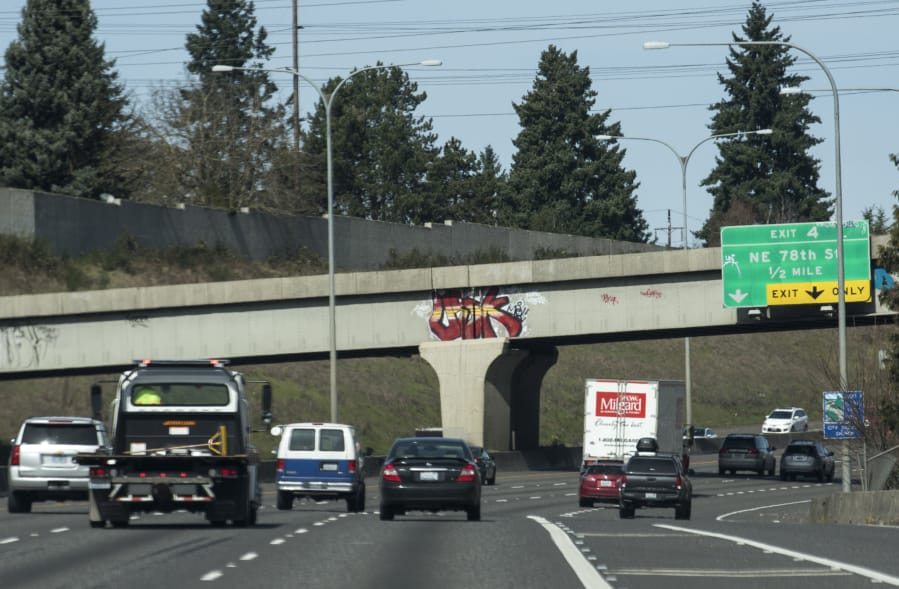Clark County Sheriff’s Office Sgt. Brent Waddell has a couple of spots in town he uses as a barometer for whether graffiti is ebbing or flowing in Vancouver and the surrounding area.
One place graffiti artists, or taggers, tend to gravitate toward is a railroad bridge just north of where state Highway 99 crosses Interstate 5. Another problem spot is an old business complex on the east side of Northeast St. Johns Road, north of 78th Street.
“There are new tags at those spots on a weekly basis,” Waddell said.
The backside of the old building occasionally gets tagged with larger murals, Curtis Gaiani, manager of Compass Coffee Roasting, said standing outside Monday. It recently got a fresh coat of paint to cover up the most recent one, Gaiani said.
The graffiti mural “was huge. It was pretty cool,” he said.
There is graffiti throughout the city, according to officials at schools and various public agencies. Several residents have reached out to The Columbian through our Clark Asks feature over the past several months and asked: Has anyone noticed the increase in graffiti on road signs, overpasses and buildings?
All signs — and other landmarks covered in spray paint — point to yes, or probably. How much graffiti may be increasing is hard to pin down, as the number of vandalized spots are recorded by the organization tasked with cleaning them up, or not at all.
Vancouver Public Works operations crews remove graffiti on city streets and rights of way. Clark Public Utilities cleans up utilities boxes, while the Washington Department of Transportation is responsible for cleanups on state highways and overpasses. C-Tran dispatches employees to spots on bus stops and buses.
Waddell, a former gang detective, said there are generally two types of graffiti. There’s gang-related graffiti, which identifies territory, crews and individuals. The second kind of graffiti is associated with taggers, artists who want name recognition through their work.
Simply put, gang graffiti is associated with intimidation. Tagger graffiti is more about seeking admiration. Waddell said he’s noticed an uptick in both. Deputies and officers have told him they’ve seen an increase, too.
The gang-related stuff can be found all over the city and its outlying areas. That’s because gangs don’t operate here the same way they would in a larger city like Los Angeles.
“We get competing gangs crossing each other’s tags out every once in a while, and it seems like there’s more of it lately,” Waddell said. “It ebbs and flows here, at least on the gang side of the issue. (The gangs) are fairly transient. They move from apartment complex to apartment complex, because they get kicked out. So, it’s not like other places, like, ‘This is my neighborhood.’ ”
Not all say an increase
Some agencies were unwilling to say whether there is an increase in graffiti.
Vancouver police spokeswoman Kim Kapp said graffiti is a crime that fluctuates. The police department’s crime analysts go through reports to identify increases, or to see if there are certain tags showing up in multiple locations. If increases occur, a Neighborhood Response Team may follow up, Kapp said. Residents are encouraged to photograph and report graffiti, but they’re responsible for removal if it’s on private property, she said.
The Public Works Department provided data about the number of requests it received for cleanups and completed removals for the past two years. Requests increased in the final three months of 2017 compared with the previous year.
For 2017, there were 34 requests in October, 28 in November and 48 in December. There were 22, 15 and 31 requests, respectively, for the same months in 2016, according to the public works data.
The numbers for graffiti removals started or completed by work crews over the same months vary too much to indicate any trends.
Loretta Callahan, public information officer for Vancouver Public Works, said conclusions about an increase in graffiti could not be drawn from the data. It would be inaccurate to do so, she said.
“Removal data are just that, not indicators of causation. Operations crew work outdoors year-round. Many factors could possibly be contributing to the numbers — possibilities of more public awareness, more reporting, more graffiti and other activity, daylight hours or weather,” Callahan said in an email.
Increased cleanup
Officials at the state Department of Transportation said crews go out once a month on average to clean graffiti. They have recently been going out about twice a month for Vancouver-area removals.
In January, the transportation crews spent two solid days on removals, said spokesman Bart Treece. The workers cleaned up two dozen spots, Treece said.
Since that time, the crews have spent another five or so days painting the city’s state roadways back to their original neutral tones. They targeted 137 separate locations, said spokeswoman Tamara Greenwell, who noted that number could include single bridges with multiple vandalized sections.
Treece said that crews were not dispatched to remove graffiti last year until April. For crews and supplies, it costs about $1,000 a day to do the cleanups, he said.
“We have seen a pickup in graffiti removals, specifically with certain taggers. We don’t like sharing their names because it gives them recognition, which we don’t want to give them,” Greenwell said.
Bay, Clark targeted
Vancouver Public Schools has experienced an increase of graffiti this winter over last winter. Its schools were tagged four times this winter versus one time last winter, said communications director Pat Nuzzo.
Hardest hit have been Hudson’s Bay High School and its Propstra Stadium, the school’s baseball diamond.
The graffiti has included “artistic vandalism and gang tags,” Nuzzo said.
Custodians arrive early in the morning and walk around the buildings to check for graffiti. If any graffiti is found, the maintenance department removes it by painting over it or pressure washing, depending on the surface. Graffiti is typically removed before students show up for the school day, Nuzzo said.
Clark College also said it has seen an increase. There have been a dozen instances of graffiti between December and February. Mark See, director of security and safety, characterized the total as unusual.
“I don’t see a nexus as to what’s causing the increase, as none of them seem connected,” said See. “There hasn’t been an identified suspect, and we can’t definitively say it’s a group of people either.”
Evergreen Public Schools said it did not appear that its facilities were being increasingly targeted. During the previous school year, the school district spent $7,014 to fix 24 different sites. For this school year, it’s spent $3,637 cleaning 18 spots.
The frequency of graffiti, gang- or tagger-related, tends to be cyclical, Waddell said.
“What happens is there are taggers going around all over the place, and a patrol deputy busts them,” Waddell said. “And so, those people drop off for a while. Someone may come in to replace them, or number of spots (of graffiti) may decrease for a time.”




